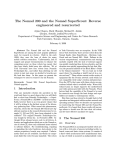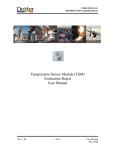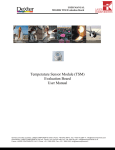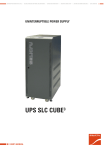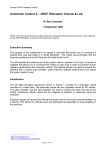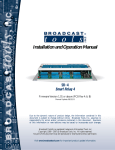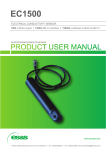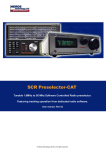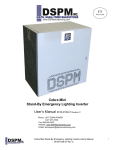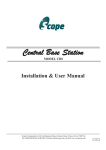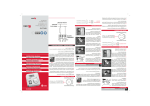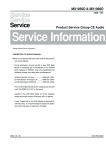Download X1 Ranging Module Pro
Transcript
X1 Ranging Module Pro™ Version 1.1 User Manual SensComp, Inc. www.senscomp.com Copyright© 2008 SensComp Inc. All Rights Reserved Proudly made in the USA FTC Table of Contents Chapter 1: 1.1 1.2 1.3 Getting Started …....…..………………………2 Introduction ...…………………………..……...2 Kit Contents ……………………………….…...2 Installing and Uninstalling Software……….......3 1.3.1 System Requirements……………..…....3 1.3.2 Installing Software………………..........3 1.3.3 Uninstalling Software ………..………...6 Chapter 2: PC Scope ………………………..……………..8 2.1 Scope Screen Controls………………..……......8 Chapter 3: Connecting X1 Ranging Module Pro™ PCB to Computer……………………………….....10 3.1 Getting Connected ...……………………..…10 Copyright Notice Copyright © 2008, SensComp Inc. All rights reserved. All text, images, graphics, and other materials in this X1 Ranging Module Pro™ User Manual are subject to the copyrights and other intellectual property rights of SensComp, Inc., its affiliated companies, and its licensors. Only SensComp authorized distributors have a limited right to modify these materials to include such distributor’s pricing and ordering information and make copies of the materials. SensComp authorized distributors may also use the SensComp logo and graphics in advertising SensComp products. Otherwise, these materials may not be modified or renamed or made a part of any other materials, nor may these materials be copied for commercial use or distribution. Specification Sheets and Application Notes may not be modified by anyone for any reason. You must retain all copyright and other proprietary notices on all copies of the materials. You shall comply with all copyright laws worldwide in your use of the materials and prevent unauthorized copying of the contents. Except as provided in this notice, SensComp, Inc. does not grant you any express or implied right in or under any patents, trademarks, copyrights or trade secret information. SensComp Inc. 36704 Commerce Road Livonia, Michigan 48150 USA Chapter 4: X1 Ranging Module Pro Circuit™ Board….11 4.1 Introduction…………………………………...11 4.2 Electrical Connections.………….………….....11 4.2.1 Power and Signals (J1 Connector)…....11 4.2.2 USB Cable (J2 Connector)…………....12 4.2.3 Transducer Connections……………....12 4.3 X1 Ranging Module Pro™ Circuit Board….....14 4.4 General Installation Procedures ……...…….....15 4.5 Calibration Procedures……………..…..…..…16 Chapter 5: 5.1 5.2 5.3 Theory of Operation………………………....18 Introduction………………………………..….18 Electrostatic Transducer…………………..…..19 X1 Ranging Module Pro™………………..…..21 Chapter 6: Reference Materials……………………….....24 6.1 Sonar Signal Timing………………………..…24 6.2 Distance Calculator ………………………..….25 Chapter 7: Specifications………………………………....26 1 Chapter 1: Getting Started 1.1 Introduction 1.3 Installing and Uninstalling Software 1.3.1 System Requirements This kit offers both a starting point as well as a complete solution sensor for Ultrasonic Range Detection and Measurements. The knowledge you gain from using this kit will enable you to identify various uses for teaching, hobby, consumer and industrial projects. SensComp’s X1 Ranging Module Pro™ w/PC Scope and Ultrasonic Electrostatic Transducer sensor system provide a solution to simplify your product design and packaging. Ultimately, the kit helps make design and development a more fluid process by taking the tedium out of testing and experimentation. It allows you to focus on your creative ideas and designs. 1.2 Kit Contents PC or Laptop Windows® XP or Vista USB Port CD-ROM drive 6 Mega-byte Available Hard Drive Space 1.3.2 Install X1 Ranging Module Pro™ PC Scope Software 1. 2. 3. Close all open programs. Insert CD into CD drive. Open ‘My Computer’ and select CD drive. Open VB_USB_INSTALL2_5_6.ms1 and follow install wizard. 1 X1 Ranging Module Pro™ PCB 1 Electrostatic Transducer 1 AC Power Adapter 1 USB Cable 1 Transducer Enclosure w/lid 4 Screws 1 Quick Start Guide 1 User Manual 1 Sensor Scope Software CD 1 Storage Case FIGURE 1-1 2 3 4. Start Installation. 6. FIGURE 1-2 5. Select location to install program. FIGURE 1-3 4 Confirm that you want to install this software. FIGURE 1-4 7. Software installs. FIGURE 1-5 5 8. Close dialog box after program installs. FIGURE 1-6 3. Software will uninstall automatically. FIGURE 1-7 1.3.3 Uninstalling Software 1. 2. To uninstall the X1 Ranging Module Pro™ Sensor Scope, insert the software CD and open the VB_USB_Install2_5_6.msi file and then follow the uninstall wizard. Select “Remove X1 Ranging Module Pro™ Sensor Scope” and click Finish. 6 7 Chapter 2: PC Scope 2.1 Scope Screen Controls 5. 6. 7. 8. 9. 10. FIGURE 2-1 11. 12. 13. Horizontal Time – Selects the proper timebase to view the input signal. Channels – Selects the channel to display input signal desired. Note: ECHO acts as the scope trigger to time all other signals. It can be selected to be displayed or not. Curser On/Off – Turns scope cursor on ►|◄off. Place the computers cursor over the pc scope cursor symbol and left click and hold while dragging cursor to the location you wish to measure. The cursor window displays Time (mS); Analog Output Voltage; and Distance to Target (Inches). Pause – Captures an image of the real-time scope screen. Print Colors – Selects a white screen window for printing scope image. Saves ink when printing. Video Colors – Selects a black screen window for better color separation for live screen images. Print – Sends captured scope images to the printer. Save – Saves captured scope images to disk. PC Scope Screen – Displays scope images. X1 Ranging Module Pro™ USB Scope Controls: 1. 2. 3. 4. Port Connected – This window indicates that the PC scope port is connect/disconnected to the selected COM port. Connect/Disconnect – Connects or disconnects the PC scope to the selected COM port. COM Port# – Indicates the COM port which the USB cable is plugged into. Sweep Delay: Delays scope sweep to view signals without having to change the selected horizontal time base. 8 9 Chapter 3: Connecting X1 Ranging Module Pro™ PCB to Computer 3.1 Getting Connected 1. 2. 3. 4. 5. 6. 7. 8. 9. Chapter 4: X1 Ranging Module Pro™ Circuit Board 4.1 Introduction Connect PCB to computer w/USB cable to an available port then to the X1 Ranging Module Pro™ board into J2. Connect the transducer (section 4.2.3) supplied in the kit to the cable at locations E1 and E2 on the PCB as shown in figure 4-1. Connect power cable to J1 noting polarity. Run SensComp Scope2_5_6 program on PC. Right click on connect button, then “OK” Press YES to let computer find port, “NO” to manually enter port number. Select “YES” Unplug the USB cable to the SensComp board, then “OK” Plug in USB cable from the SensComp Board back in to the PC “OK” Left on “Connect” button. Note: Windows may find new hardware – follow window hardware/driver install wizard (s) to install emulated RS232 COM port USB drivers. When Windows prompts you to select a file path to locate drivers, point it to the SensComp CD in your CD drive. 10. Once drivers are installed, press the connect button and the X1 Ranging Module Pro™ should start to communicate to the PC scope and you should see the REC/Vout/ECHO on your PC screen. Depending where target is, you may have to adjust horizontal time to see target trace. 10 The X1 Ranging Module Pro™ w/USB Scope sensor provides a total system in a compact package, containing an ultra sensitive electrostatic transducer and the supporting circuitry to provide a 0 to +5 VDC output with fully independent zero and span adjustments over the entire operating range of detection from 0.5’ – 20’ away. This sensor can be externally triggered or can continually sense at a 10 Hz rate. This unit also displays the ECHO, REC and Analog Output on any Windows® XP or VISTA PC and can also print hard copy images. 4.2 Electrical Connections 4.2.1 Power and Signals (J1 Connector) Pin 1 – Power Supply (+) Pin 2 – Ground (-) Pin 3 – External Trigger Pin 4 – Trigger Enable Pin 5 – ECHO Pin 6 - Analog Output Pin 7 – N.C. 1. 2. Power Supply – Requires a +8 to +24 VDC regulated power source with a 30 mA current capacity. Ground – Common return for DC power supply, analog output and clock signals. 11 3. 4. 5. 6. 7. External Trigger – External clock pulse rising edge will start the transmit/receive cycle. Accepts TTL compatible logic level clock signals (0-5 VDC) up to 50 HZ. Trigger Enable – Pull this input low (GND) to enable the external trigger clock. ECHO – Is a pulse width modulated (PWM) output from 0 to 5 VDC. It is proportional from the start of the transmit signal to the reception of the echo return signal. Analog Output – 0 to 5 VDC output that is proportional to the distance between the Minimum (MIN) and Maximum (MAX) range setting. By reverse setting the MIN and MAX range settings the slope of this output will be 5 to 0 VDC. No Connection. (N.C.) 4.2.2 USB Cable (J2 Connector) 1. 2. Using the supplied USB cable, plug the small end (Micro B male) into J2 on the X1 Ranging Module Pro™ board. Plug the larger connector (USB A male) into an available USB port on your computer. 4.2.3 Transducer Connections FIGURE 4-1 1. 2. E1 - Transducer positive (+) Black Wire E2 - Transducer ground (-) 12 Note: It may be necessary to connect a 470-1000 ufd electrolytic capacitor across the power supply (+) to ground (-) in order to provide enough inrush current (2 Amps for 500 uS) during the transmit cycle. (This capacitor is not required using the power supply in kit.) 13 4.3 X1 Ranging Module Pro™ Circuit Board • • • • • • • MIN – Sets minimum range of detection window. Scale Adjust – Adjusts analog output voltage at full range scale. Power LED (LED 6) – Indicates power is on. Target Detect LED (LED 1) – Flashes when setting MIN/MAX ranges, also lights when a target is detected between the set MIN/MAX ranges during operation. TP1 – Test Point 1 (REC) Amplified return echoes. TP2 – Test Point 2 (BLNK) transmit/receive blanking signal. TP3 – Test Point 3 (ECHO) Is a PWM, pulse width modulated signal which is proportional to the distance from the transducer to the detected target. 4.4 General Installation Procedures FIGURE 4-2 • • • • • • • • • • J1 - Power and sensor signals connections. J2 – USB port. User LEDs (LED 2, 3) – For future use. USB Comm. LEDs (LED 3, 4) – These LEDs verify that the X1 Ranging Module Pro™ board is communicating to the PC. USB Boot – Not used. Reset – Reset’s the PIC 18F4550 uProcessor. XDCR E1 – Transducer (+) connection. XDCR E2 – Transducer (-) connection. GAIN – Adjust the receive gain of the sensor. MAX – Sets maximum range of detection window. 14 1. 2. 3. 4. Always mount the sensor’s transducer in a suitable dry location. The X1 Ranging Module Pro™ is designed to be used indoors or in protected environments only. Excessive moistures in the circuit board (and transducer) will result in damage and improper operation, and will void all warranties. Mount the X1 Ranging Module Pro™ transducer as far off the ground as practical, in a location where environmental interference sources are minimized (examples are EMI sources, air nozzles, excessive air turbulence, etc.) If necessary, adjust the gain to the minimum setting necessary to ensure reliable target detection (excessive gain can result in false detections). As supplied, the X1 Ranging Module Pro™ has been calibrated and should function without further calibration. 15 4.5 Calibration Procedures 1. 2. 3. 4. 6. Apply DC power (see 4.2 Electrical Connections). Connect a DC voltmeter (DVM) Plus (+) lead to the Analog Output (pin 6) and the DVM Minus (-) lead to Common (pin 2). Place the target at the maximum desired distance for the full-scale voltage output. Depress and hold the “MAX” RANGE SET push button, and wait for the detect LED1 indicator to stop flashing and the transducer generates a “beep” sound before releasing. The X1 Ranging Module Pro™ is now calibrated to your desired target distance for full scale analog voltage output. Place the target at the desired minimum distance for the zero voltage output. Depress and hold the “MIN” RANGE SET push button, and wait for the detect LED1 indicator to stop flashing and the transducer to generate a “beep” sound before releasing. The X1 Ranging Module Pro™ is now calibrated to your desired target distance for zero analog voltage output. Gain Control: The X1 Ranging Module Pro™ gain was pre-set at the factory for optimum performance. To re-calibrate the “GAIN” potentiometer, place the target at the maximum desired detection distance. Rotate the GAIN potentiometer fully counterclockwise (CCW). Now slowly rotate the GAIN control clockwise (CW) until detection occurs. Rotate the Gain control CW an additional 1/16 turn. Note: Always calibrate the GAIN control for minimum gain required for reliable detection. Excessive gain may result in false target detection. Note: The slope of the analog output voltage can be changed by reversing the MIN and MAX range settings, i.e. MAX = 0 volts and MIN = +5 volts. 5. Scale Adjustment: Place a target at the absolute maximum detect distance desired (20 feet max.) to assure maximum voltage output at that distance. Adjust the “SCALE Adjust” potentiometer until a +5.0 VDC reading is obtained. 16 17 Chapter 5: Theory of Operation 5.1 Introduction Determining range by using ultrasonic sound waves for echo ranging is a simple process. A short burst of ultrasonic energy is generated electronically, amplified and transmitted by a transducer. The signal travels through the medium (in this case air), reflects from the target object, and returns to the transducer. This signal is then received, amplified, and processed by the system electronics. The time for this round trip can then be determined, and knowing the correct speed of sound, the distance to the object calculated. The simple ultrasonic echo ranging system included in the X1 Ranging Module Pro™ kit is composed of two main parts: the transducer and the electronics drive module. The transducer is an electrostatic type transducer used to both transmit the signal out, and also receive the returning echo. The electronic ranging module contains all of the circuitry needed to generate the transmit signal, drive the transducer, receive the echo, and process the information received by the transducer. The distance from the transducer to the target can then be computed with additional circuitry designed by the end user, knowing the speed of sound in air (or other gas) and the time interval between the transmit signal and the received echo as provided by the sonar ranging module. The X1 Ranging Module Pro™ operates over a distance range of 6 inches to 20 feet (0.15 to 6.10 meters), increasing the receiving amplifier gain and decreasing the bandwidth with time to compensate for signal losses over the distance range. locks onto an echo. Once the threshold level of the integrator is reached, a signal is generated to indicate a received echo. The logic level outputs for the transmit signal and received echo can be used to perform control functions or calculate distance to the object with a minimum of additional circuitry. 5.2 Electrostatic Transducer The key to the system is the unique electrostatic transducer (Figure 5-1). It is composed of a very thin, Kapton-film diaphragm vacuum coated with gold to form the negative electrode. The positive electrode is the coined aluminum backplate which also provides the resonant structure for the diaphragm. Mechanical bias, as well as electrical contact is provided by a stainless steel leaf spring. The transducer is 4 centimeters in diameter and weighs only 8 grams. The system drives the transducer with a 1 millisecond tone burst at 400 Volts peak-to-peak and 200 volts DC bias, producing an output sound pressure level at 50 kHz of approximately 110 dB SPL at 1 meter. The transmitting response (Figure 5-2) is seen to be quite flat to beyond 100 kHz. This provides the transducer with very fast damping so that ranging at high gain can be achieved as quickly as possible after transmit. Then, to minimize the system’s susceptibility to noise pick-up, a signal integration scheme is employed before the system The very wide bandwidth and extremely high output allows the system to operate over a very wide distance range. The system is capable of a minimum range of 6 inches. With a receiving sensitivity (Figure 5-3) of -42 dB re 1 Volt/Pascal, the transducer provides sufficient output for the system designed to operate to a maximum range of 35 feet. The transducer is approximately 1.5 inches in diameter, yielding a 3dB full angle beam width (Figure 5-4) of approximately 15 degrees at 50 kHz. 18 19 FIGURE 5-4 5.3 X1 Ranging Module Pro™ The X1 Ranging Module Pro™ sonar system electronics are integrated onto a single module (Figure 5-5) utilizing custom integrated circuits to perform the analog and digital functions. These ICs are packaged along with the necessary discrete components on a single printed circuit board. When activated, the system generates a series of 49.4 kHz pulses during a 1 millisecond long transmit period. This signal is amplified with a step-up transformer to 400 Volts peak-to-peak with a 200 Volt DC bias to drive the transducer. The bias voltage is maintained on the transducer with a storage capacitor during the time the transducer acts as a microphone to receive the echo. The receiving amplifier is blanked for 0.9 milliseconds following the end of the transmit signal to allow sufficient time for the energy in the transducer diaphragm to decay below the threshold level. FIGURE 5-1 FIGURE 5-3 FIGURE 5-2 20 21 The gain of the receiving amplifier increases as a function of time (Figure 5-6) to compensate for signal losses at further distances and decreases its bandwidth to reduce noise pick-up. When a signal is received by the system, a current source is turned on if the signal is above a preset threshold level. The current source charges a capacitor until the voltage on the capacitor reaches 1.2 Volts. The system generates a logic level output signal at the time of the received echo. The time interval between the transmit signal start ( Internal CLK or Ext. Trigger Input) and the received echo (ECHO Output) can then be measured, multiplying this time by the speed of sound yields the round trip distance to the object. If the actual distance is not required, a simpler timing circuit can be employed to determine when an object comes within some preset zone of the sensor. FIGURE 5-6 Note: ONLY the graphs of the first eight gain steps are included here for clarity. Step 9-11 are identical to step 8 except that each successive step is increased in gain by 4 dB. These graphs are generated from theoretical information, not experimental data. FIGURE 5-5 22 23 Chapter 6: Reference Materials 6.2 Distance Calculator Ultra Sonic Sensor Distance Calculator 6.1 Sonar Signal Timing ENGLISH Calculator ***Sonar Signal Timing D – Distance in Feet per Second (ft/s) D – Distance in Inches per Second (in/s) TOF – Time of Flight = Time in Second (s) ECHO signal (Positive Pulse Width) SP – Speed of Sound in Feet per Second (ft/s) @ 68º F = 1125.9842 SP – Speed of Sound in Feet per Second (ft/s) @ 32º F = 1087.2703 D(fps) = TOF(s) x SP 2 D(ips) = D(ft/s) x 12 METRIC Calculator D – Distance in Meters per Second (m/s) D – Distance in Millimeters per Second (mm/s) T – Time of Flight = Time in Second (s) ECHO signal (Positive Pulse Width) S – Speed of Sound in Meters per Second (m/s) @ 20º C = 343.2 S – Speed of Sound in Meters per Second (m/s) @ 0º C = 331.4 D(m/s) = T(s) x SP(m/s) 2 FIGURE 6-1 *** Image shown is taken using an actual high speed oscilloscope for clarity, some high speed transmit signals not enabled in PC Scope. Dft = 4.5 mS x 1125.9842 2 Dft = 5.0669/2 = 2.533 Feet Din = 2.533 x 12 = 30.40 Inches 24 D(mm/s) = D(m/s) x 1000 D(in/s) = D(mm/s) 2 METRIC to ENGLISH / METRIC to METRIC Conversions Meters to Feet = Meters ÷ .3048 Meters to Millimeters = Meters x 1000 Millimeters to Meters = Millimeters ÷ Meters Millimeters to Inches = (Millimeters ÷ 25.4) or (Millimeters x 0.03937) ºC to ºF = (ºC x 1.8) + 32 ENGLISH to Metric / ENGLISH to ENGLISH Conversions Feet to Meters = Feet x .3048 Feet to Inches = Feet x 12 Inches to Feet = Inches ÷ 12 Inches to Millimeters = (Inches x 25.4) or (Inches ÷ 0.03937) ºF to ºC = (ºF – 32) ÷ 1.8 25 Chapter 7: Specifications X1 Ranging Module Pro™ Instrument Grade, Environmental Grade, and Open Face Specifications ***Specifications subject to change without notice. Distance Range: 0.15 - 6.10 M (0.5 -20 feet) Accuracy (over entire range)..........± 0.1% (0.025-0.3 M range = ± 1.0%) Beam Pattern.......... (Typically 15° nominal) Repetition Rate (astable)..........10 Hz May be externally triggered up to a 50 Hz rate Output Voltage (Analog)..........0 to 5 VDC Output Current (maximum)..........5 ma Output Response Time: Analog output is filtered to the approximate formula: VOUT = 0.9 (Vnew value) + 0.1(Vpast avg. value) FIGURE 7-1 Power Requirements..........8 to 24 VDC (for 5V output) (Maximum Current = 30 mA) Operating Temperature..........-40 to +85° C (-40 to 185° F) Weight......................................................17 grams (0.6 oz) Dimensions...............................................2.22” x 1.77” Housing, Standard Finish Instrument Grade............Flat Black Cold Rolled Steel Environmental Grade.....304 Stainless Steel Open Face……………Parylene Coated 304 Stainless Steel FIGURE 7-2 26 27















